Unit 1 What’s the matter?导学案(5课时)
文档属性
| 名称 | Unit 1 What’s the matter?导学案(5课时) | 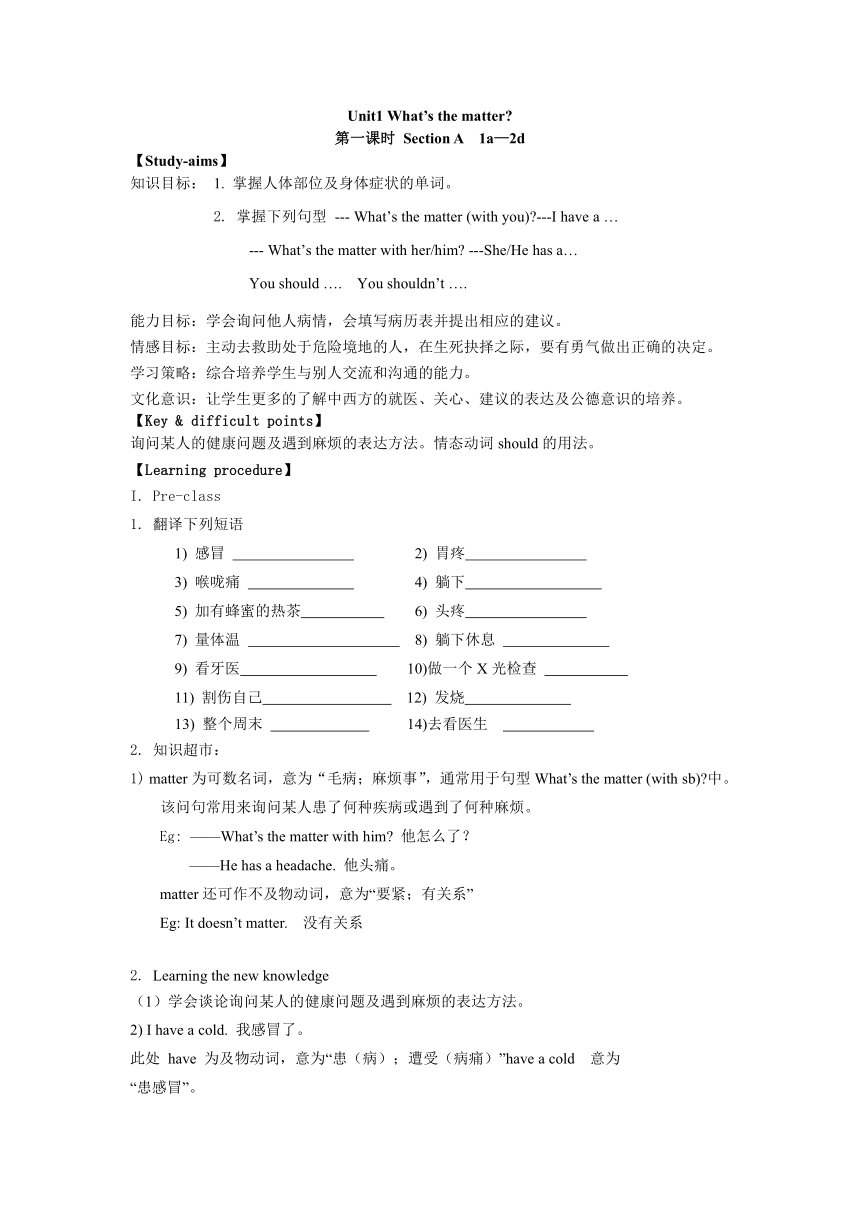 | |
| 格式 | zip | ||
| 文件大小 | 24.8KB | ||
| 资源类型 | 教案 | ||
| 版本资源 | 人教新目标(Go for it)版 | ||
| 科目 | 英语 | ||
| 更新时间 | 2017-03-30 12:20:59 | ||
图片预览

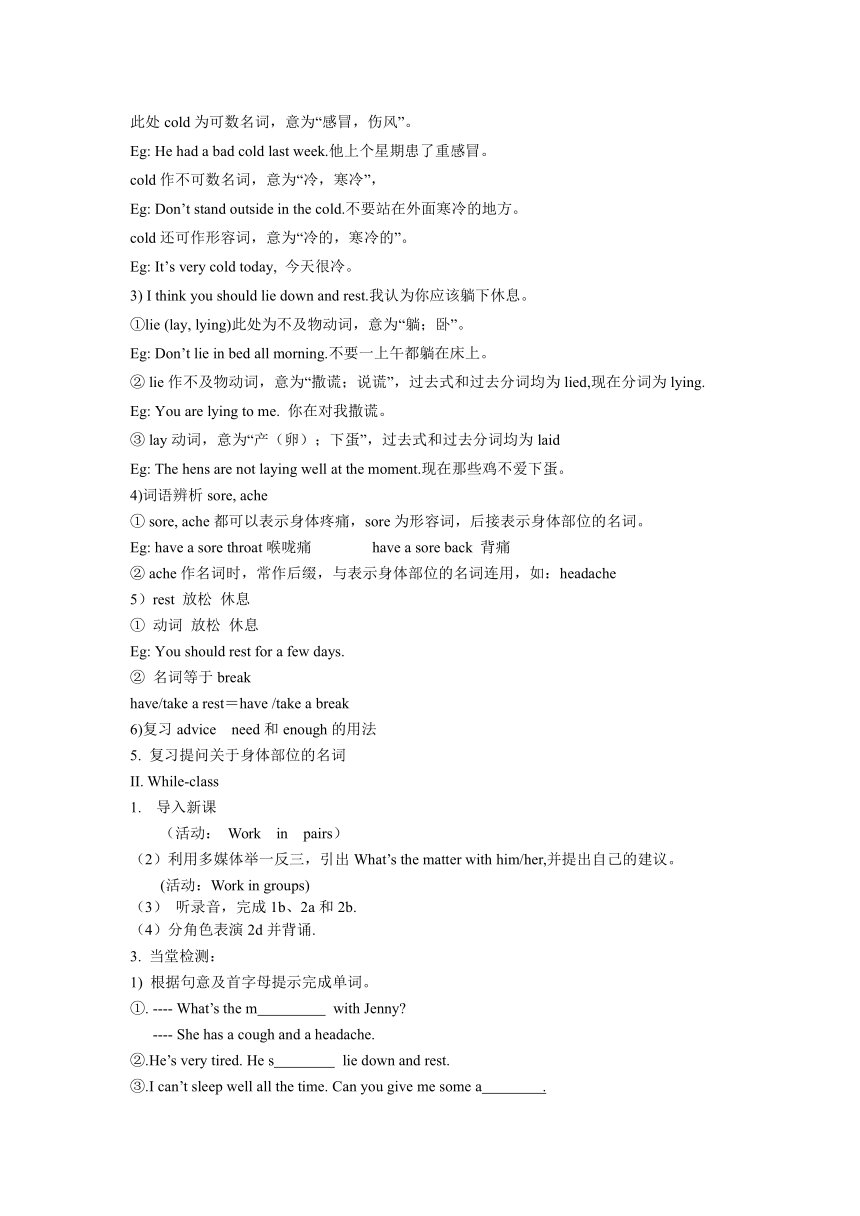
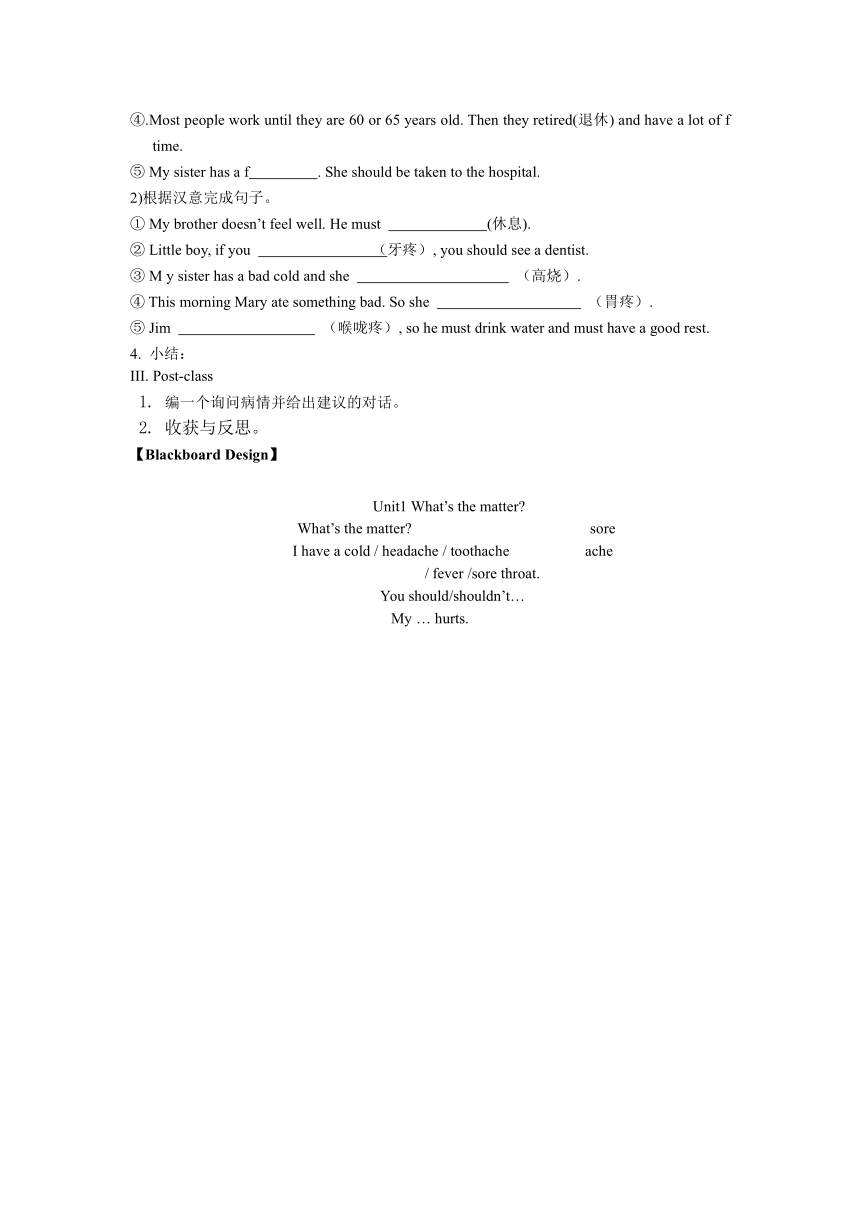
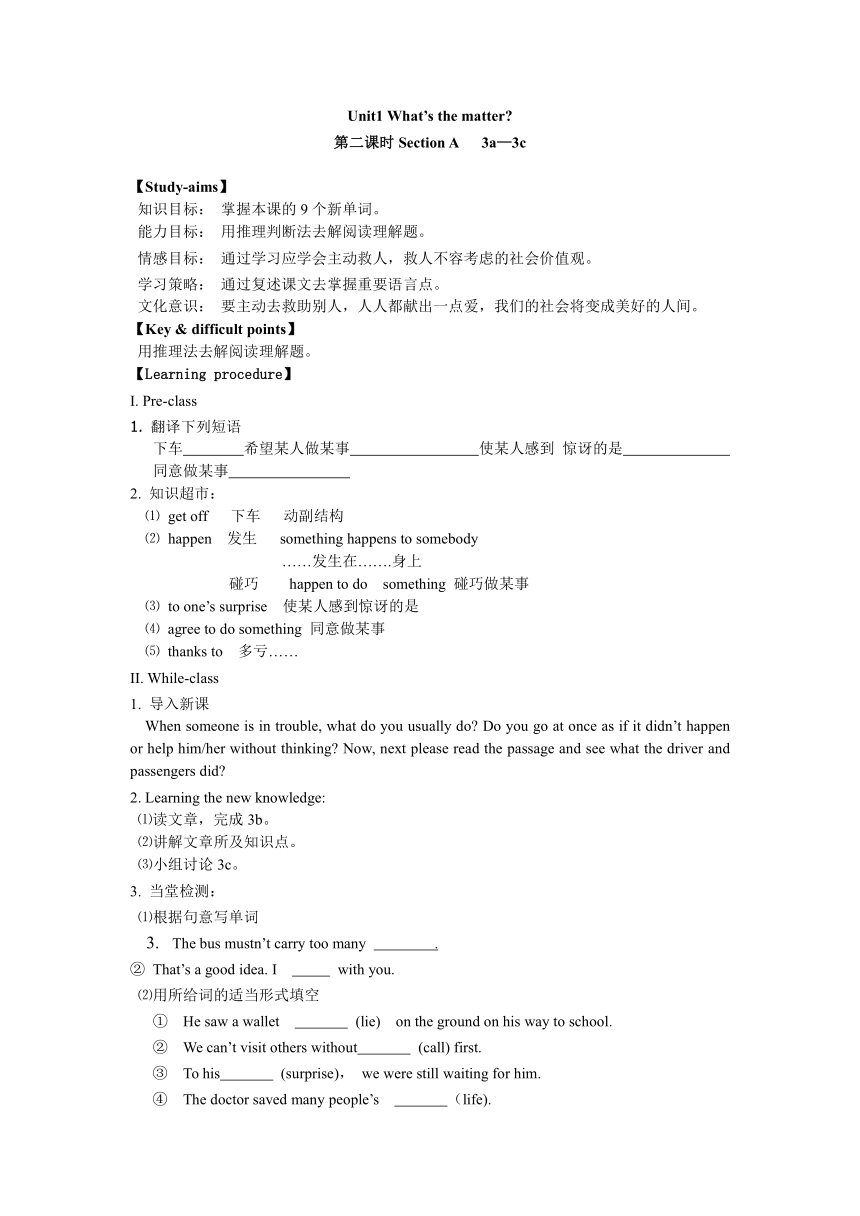
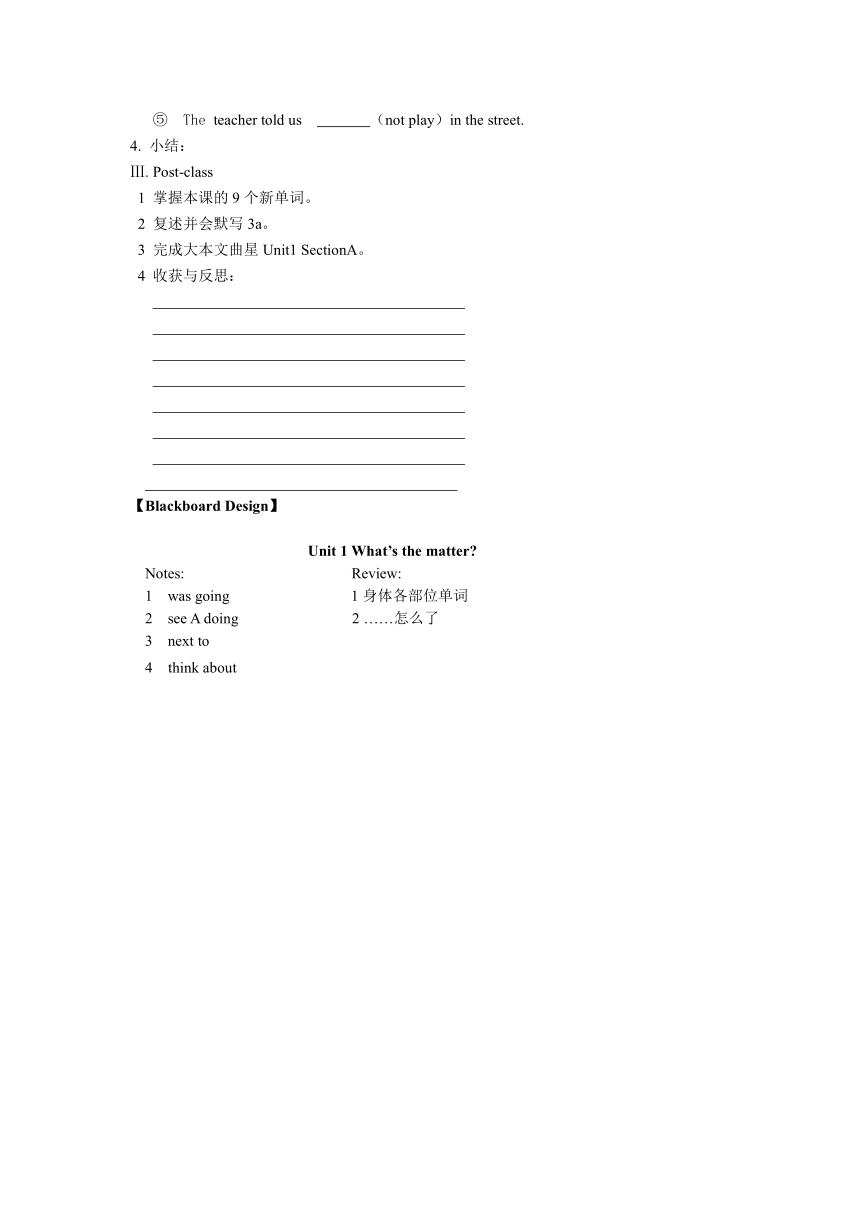
文档简介
Unit1
What’s
the
matter
第一课时
Section
A
1a—2d
【Study-aims】
知识目标:
1.
掌握人体部位及身体症状的单词。
2.
掌握下列句型
---
What’s
the
matter
(with
you) ---I
have
a
…
---
What’s
the
matter
with
her/him
---She/He
has
a…
You
should
….
You
shouldn’t
….
能力目标:学会询问他人病情,会填写病历表并提出相应的建议。
情感目标:主动去救助处于危险境地的人,在生死抉择之际,要有勇气做出正确的决定。
学习策略:综合培养学生与别人交流和沟通的能力。
文化意识:让学生更多的了解中西方的就医、关心、建议的表达及公德意识的培养。
【Key
&
difficult
points】
询问某人的健康问题及遇到麻烦的表达方法。情态动词should的用法。
【Learning
procedure】
I.
Pre-class
1.
翻译下列短语
1)
感冒
2)
胃疼
3)
喉咙痛
4)
躺下
5)
加有蜂蜜的热茶
6)
头疼
7)
量体温
8)
躺下休息
9)
看牙医
10)做一个X光检查
11)
割伤自己
12)
发烧
13)
整个周末
14)去看医生
2.
知识超市:
1)
matter为可数名词,意为“毛病;麻烦事”,通常用于句型What’s
the
matter
(with
sb) 中。该问句常用来询问某人患了何种疾病或遇到了何种麻烦。
Eg:
——What’s
the
matter
with
him
他怎么了?
——He
has
a
headache.
他头痛。
matter还可作不及物动词,意为“要紧;有关系”
Eg:
It
doesn’t
matter.
没有关系
2.
Learning
the
new
knowledge
(1)学会谈论询问某人的健康问题及遇到麻烦的表达方法。
2)
I
have
a
cold.
我感冒了。
此处
have
为及物动词,意为“患(病);遭受(病痛)”have
a
cold
意为
“患感冒”。
此处cold为可数名词,意为“感冒,伤风”。
Eg:
He
had
a
bad
cold
last
week.他上个星期患了重感冒。
cold作不可数名词,意为“冷,寒冷”,
Eg:
Don’t
stand
outside
in
the
cold.不要站在外面寒冷的地方。
cold还可作形容词,意为“冷的,寒冷的”。
Eg:
It’s
very
cold
today,
今天很冷。
3)
I
think
you
should
lie
down
and
rest.我认为你应该躺下休息。
①lie
(lay,
lying)此处为不及物动词,意为“躺;卧”。
Eg:
Don’t
lie
in
bed
all
morning.不要一上午都躺在床上。
②
lie作不及物动词,意为“撒谎;说谎”,过去式和过去分词均为lied,现在分词为lying.
Eg:
You
are
lying
to
me.
你在对我撒谎。
③
lay动词,意为“产(卵);下蛋”,过去式和过去分词均为laid
Eg:
The
hens
are
not
laying
well
at
the
moment.现在那些鸡不爱下蛋。
4)词语辨析sore,
ache
①
sore,
ache都可以表示身体疼痛,sore为形容词,后接表示身体部位的名词。
Eg:
have
a
sore
throat喉咙痛
have
a
sore
back
背痛
②
ache作名词时,常作后缀,与表示身体部位的名词连用,如:headache
5)rest
放松
休息
①
动词
放松
休息
Eg:
You
should
rest
for
a
few
days.
②
名词等于break
have/take
a
rest=have
/take
a
break
6)复习advice
need和enough的用法
5.
复习提问关于身体部位的名词
II.
While-class
导入新课
(活动:
Work
in
pairs)
(2)利用多媒体举一反三,引出What’s
the
matter
with
him/her,并提出自己的建议。
(活动:Work
in
groups)
(3)
听录音,完成1b、2a和2b.
(4)分角色表演2d并背诵.
3.
当堂检测:
1)
根据句意及首字母提示完成单词。
①.
----
What’s
the
m
with
Jenny
----
She
has
a
cough
and
a
headache.
②.He’s
very
tired.
He
s
lie
down
and
rest.
③.I
can’t
sleep
well
all
the
time.
Can
you
give
me
some
a
.
④.Most
people
work
until
they
are
60
or
65
years
old.
Then
they
retired(退休)
and
have
a
lot
of
f
time.
⑤
My
sister
has
a
f
.
She
should
be
taken
to
the
hospital.
2)根据汉意完成句子。
①
My
brother
doesn’t
feel
well.
He
must
(休息).
②
Little
boy,
if
you
(牙疼),
you
should
see
a
dentist.
③
M
y
sister
has
a
bad
cold
and
she
(高烧).
④
This
morning
Mary
ate
something
bad.
So
she
(胃疼).
⑤
Jim
(喉咙疼),
so
he
must
drink
water
and
must
have
a
good
rest.
4.
小结:
III.
Post-class
编一个询问病情并给出建议的对话。
收获与反思。
【Blackboard
Design】
Unit1
What’s
the
matter
What’s
the
matter
sore
I
have
a
cold
/
headache
/
toothache
ache
/
fever
/sore
throat.
You
should/shouldn’t…
My
…
hurts.
Unit1
What’s
the
matter
第二课时Section
A
3a—3c
【Study-aims】
知识目标:
掌握本课的9个新单词。
能力目标:
用推理判断法去解阅读理解题。
情感目标:
通过学习应学会主动救人,救人不容考虑的社会价值观。
学习策略:
通过复述课文去掌握重要语言点。
文化意识:
要主动去救助别人,人人都献出一点爱,我们的社会将变成美好的人间。
【Key
&
difficult
points】
用推理法去解阅读理解题。
【Learning
procedure】
I.
Pre-class
1.
翻译下列短语
下车
希望某人做某事
使某人感到
惊讶的是
同意做某事
2.
知识超市:
⑴
get
off
下车
动副结构
⑵
happen
发生
something
happens
to
somebody
……发生在…….身上
碰巧
happen
to
do
something
碰巧做某事
⑶
to
one’s
surprise
使某人感到惊讶的是
⑷
agree
to
do
something
同意做某事
⑸
thanks
to
多亏……
II.
While-class
1.
导入新课
When
someone
is
in
trouble,
what
do
you
usually
do
Do
you
go
at
once
as
if
it
didn’t
happen
or
help
him/her
without
thinking
Now,
next
please
read
the
passage
and
see
what
the
driver
and
passengers
did
2.
Learning
the
new
knowledge:
⑴读文章,完成3b。
⑵讲解文章所及知识点。
⑶小组讨论3c。
3.
当堂检测:
⑴根据句意写单词
The
bus
mustn’t
carry
too
many
.
②
That’s
a
good
idea.
I
with
you.
⑵用所给词的适当形式填空
①
He
saw
a
wallet
(lie)
on
the
ground
on
his
way
to
school.
②
We
can’t
visit
others
without
(call)
first.
③
To
his
(surprise),
we
were
still
waiting
for
him.
④
The
doctor
saved
many
people’s
(life).
⑤
The
teacher
told
us
(not
play)in
the
street.
4.
小结:
Ⅲ.
Post-class
1
掌握本课的9个新单词。
2
复述并会默写3a。
3
完成大本文曲星Unit1
SectionA。
4
收获与反思:
【Blackboard
Design】
Unit
1
What’s
the
matter
Notes:
Review:
1
was
going
1身体各部位单词
2
see
A
doing
2
……怎么了
3
next
to
4
think
about
Unit1
What’s
the
matter
第三课时Grammar
Focus—Section
B
1d
【Study-aims】
知识目标:能够初步识记单词:herself
,bandage,sick,knee,nosebleed和背会句子中的短语和重要语句(详见知识超市)。
能力目标:灵活运用相关单词和短语,学会谈论健康问题;学会提建议。
情感目标:学会当事故发生时,采取应急措施。
学习策略:通过图解巧辨来区别同义词及短语。
文化意识:了解西方国家有关健康问题及遇到麻烦的表达方法
。
【Key
&
difficult
points】
学会询问某人的健康问题及遇到麻烦的表达方法。
【Learning
procedure】
I.
Pre-class
1.
翻译下列短语
看牙医
______
躺下
______
做个X光检查
______
量体温
______
在...上敷药
______
发烧
______
背痛
______
牙痛
______
看医生
______
喉咙痛
______
胃痛
______
摔倒
______
去医院
______
2.
根据汉意完成下列句子
(1) 你怎么了?
II、知识超市:
1、yourself为反身代词,意为“你自己,自己”。其复数形式为yourselves,意为“你们自己”。
She
hits
at
him.她朝他打去。
hit为名词,意为“打;打击;成功;红极一时的人物或事物”。
Did
you
learn
English
by
yourself
你是自学英语的吗?
I
hope
you’ll
enjoy
yourselves.我希望你们能玩得高兴。
2、Did
you
fall
down 你摔倒了吗?
fall(fell,
fallen)作不及物动词,意为“倒下;降落;落下;降临”。
(1)常见的fall短语:
动词+副词
fall
down
摔倒
fall
behind落后
fall
in倒塌
动词+介词+名词/代词
fall
from
the
tree从树上跌下fall
into
the
river
掉进河里fall
on
the
ground落到地上
fall
off
the
chair从椅子上掉下来
连系动词+形容词
fall
asleep入睡
(2)fall作名词,相当于autumn,意为“秋天”。
3、pot
on为“动词+副词”短语,意为“穿上;戴上”。代词作其宾语时,须放在put
on的中间。
He
put
on
a
coat
and
went
out.
他穿上一件外套就出去了。
辨析:put
on
,wear,
dress与(be)in
put
on
“穿(衣);戴(帽)”,表动作
Put
on
warm
clothes,
or
you’ll
catch
a
cold.穿上暖和的衣服,否则你会感冒的。
wear
“穿(衣服)”,及物动词,表状态
The
children
are
wearing
nice
clothes
today.今天孩子们都穿着漂亮的衣服。
dress
“(给……)穿衣服”,作及物动词,宾语只能为人
I
dress
him
every
morning.我每天早晨给他穿衣服。
(be)in
介词,“穿着”,后面接表衣服的名词或表示颜色的形容词,表状态。
bi
in同be
dressed
in
The
girl
in
red
is
his
daughter.穿红衣服的女孩是他的女儿。
4、hurt
为及物动词,意为“使受伤;弄痛”,过去式和过去分词都是hurt。
He
hurt
his
right
knee.他伤了右膝。
hurt作为不及物动词,意为“疼痛”。
My
feet
hurt
when
I
walk.我走路时脚痛。
【拓展】hit为及物动词,意为“打,打击,击中(某人或某物)”。
She
hit
me
on
the
head
with
a
book.她用本书打我的头。
hit有时为不及物动词,意为“打击;撞击”。
tell为及物动词,tell
sb.(not)to
do
sth.意为“告诉某人(不要)做某事”。
He
told
me
to
write
a
report.他叫我去写个报告。
The
police
told
the
children
not
to
play
in
the
street.警察告诉孩子不要在街道上玩。
II.
While-class
1.
导入新课
A
cold
headache
fever
is
inevitable,
do
you
know
how
to
deal
with
You
may
go
to
a
doctor,
lie
down
and
rest,
drink
some
hot
tea
with
honey
and
so
on.
Should
use
different
methods
to
deal
with
different
situation.
Today
let’s
learn
Unit1
What’s
the
matter
2.
Learning
the
new
knowledge:
(1)掌握Grammar
Focus
(2)完成4a,4b
(3)活动One
student
mimes
a
problem.
The
other
students
in
your
group
guess
the
problem
and
give
advice.
A:
What’s
the
matter
Did
you
hurt
yourself
playing
soccer
B:
No,
I
didn’t.
C:
Did
you
fall
down
B:
Yes,
I
did.
D:
You
should
go
home
and
get
some
rest.
合作完成Section
B(1a),讲解句子中的知识点,学会事故发生时如何处理的表达方法。
(5)听力,完成1b,1c(活动:Pair
work
练习句型)
A:
Who
came
to
your
office
today
B:First,a
boy
came
in.
He
hurt
himself
in
P.E.class.
A:
What
happened
B:...
当堂检测:
(一)根据句意及首字母提示完成单词。
1.
The
little
boy
h______
his
leg
in
P.E.
Class.
2.
My
brother
got
h
______
on
the
head
by
a
ball.
3.We
should
be
careful,or
we
may
cut
o_________.
4.
The
old
man
has
problem
b______.
5.
One
of
my
k______
got
hurt
in
the
game.
(二)单项选择。
(
)
1.His
words
______
the
feelings
of
Chinese
people.
A.
cut
B.
hit
C.
hurt
D.
clean
(
)
2.We
have
problems
______
English.
A.
learn
B.
learned
C.
to
learn
D.
learning
(
)
3.The
knife(刀子)
______
one
of
my
feet
just
now.
A.
cut
B.
cutting
C.
cuts
D.
to
cut
(
)
4.This
summer
is
too
hot,
so
many
people
get
______
in
the
sun.
A.
hit
B.
sunburned
C.
burn
D.
old
(
)
5.Nobody
can
help
us
,
except(除了)
______
.
A.
yourself
B.
myself
C.
ourselves
D.
herself
4.
小结:
III.
Post-class
1.
能够流利的表达事故发生时以及处理的建议的句型。
2.
会读会写单词及短语bandage
,sick,
knee
,nosebleed
,
put
on
,
take
one’s
temperature,
and
so
on.
3.
收获与反思。
【Blackboard
Design】
Unit1
What’s
the
matter
Grammar
Focus—Section
B
1d
put
on
,wear
,
dress,
in
之间的区别
hurt的用法
tell
sb.(not)
to
do
Unit1
What’s
the
matter
第四课时Section
B
2a—2e
【Study-aims】
知识目标:掌握6、7页单词和短语。
能力目标:掌握课文中的重点词汇及相关短语,并灵活运用。
情感目标:主动去救助处于危险境地的人,
在生死抉择之际,
需有勇气做出正确的决定。
学习策略:“推理判断法”解阅读理解题。
文化意识:在生死抉择之际,
需有勇气做出正确的决定。
【Key
&
difficult
points】1
单词accident,
importance,
decision
and
death
的用法。
2
短语be
used
to
的用法。
【Learning
procedure】
I.
Pre-class
1.
翻译下列短语
⑴
用完
耗尽
⑵
习惯于
⑶做决定
⑷
放弃
⑸
失去生命
⑹
继续做某事
2
阅读2b,完成2c、2d
和2e的练习。
3.
知识超市:
1)be
used
to
意为“习惯于……”,后接名词、代词或动名词,
He
is
used
to
hard
work.
他习惯于艰苦的工作。
She
is
used
to
getting
up
early.
她习惯于早起。
2)run
out
of
是“动词+副词+介词”的短语。of
后接宾语,
主语通常是表示“人”的名词。
I
have
run
out
of
paper.
我的纸用完了。
【拓展】1)
run
out
of
也可以表示“从……跑出来”的意思。
The
dog
ran
out
of
the
room.
这条狗从房间里跑了出来。
2)
sth.
run(s)
out
表示“某物用完了”
Our
food
will
soon
run
out.
我们的食物快吃完了。
II.
While-class
1.
导入新课
Making
good
decisions
is
very
important
when
you
are
in
trouble.
Do
you
know
the
book“Between
a
Rock
and
a
Hard
Place”
Now
let’s
read
the
passage
of
Page
6.
2.
Learning
the
new
knowledge
⑴检查课前活动完成情况。
⑵通过阅读文章,获取具体的信息,
解答问题。
⑶师生共同完成对短文的理解,
呈现新知识、讲解短语。
⑷
听录音,读课文。
⑸
让学生根据课文的理解复述课文
3.
当堂检测:
⑴根据首字母写单词
①
Many
climbers
like
to
take
r
in
their
lives.
②
Be
careful.
A
car
may
h
you.
③
In
different
s
,
we
should
always
keep
calm.
④
By
the
sea,
there
are
many
r
.
⑤
We
cut
things
with
a
k
.
⑵
用所给词的适当形式填空
①
Finally,
he
made
a
(decide)
to
go
to
Beijing.
②
Everyone
knows
the
(important)of
studying
English.
③
Lily
is
(interest)in
the
(interest)
stories.
④
We
all
hope
(win
)the
game.
⑤
After
(eat)supper,
we
often
take
a
walk.
4.
小结:
Ⅲ.
Post-class
1作业:背诵本课时重点词汇、短语、句型。
2完成大本文曲星Unit1SB习题
3收获与反思:
【Blackboard
Design】
Unit
1
What’s
the
matter be
used
to
He
is
used
to
hard
work.
She
is
used
to
getting
up
early.
run
out
of
I
have
run
out
of
paper.
The
dog
ran
out
of
the
room.
Our
food
will
soon
run
out.
Unit1
What’s
the
matter
第五课时Section
B
3a—self
check
【Study-aims】
知识目标:询问某人的健康问题及遇到麻烦时的表达方法;情态助动词should用法。
能力目标:培养学生询问某人患了何病 遇到何麻烦几种表达结构。
情感目标:学会关心他人,主动救助处于危险境地的人,在紧要关头,有勇气做出正确的决定。
学习策略:掌握文中的重点词汇及相关短语并灵活运用。学会谈论健康问题,学会提出建议。
【Key
&
difficult
points】
询问某人的健康问题及遇到麻烦的表达方法,情态动词should的用法。
【Learning
procedure】
I.
Pre-class
1.
写出下列单词:
(1)事故
______
(2)
感觉
______
(3)事情
______
(4)病的
______
(
5)感冒
______
(6)头痛
______
(
7)
背痛______
(8)牙痛
______
(
9)胃痛
______
(10)
眼痛
______
(11)脚痛
______
(
12)耳痛
______
(13)鼻出血
______
(14)晒伤的
______
(15)意外
_____
2.知识超市
(1)询问某人患病或遇到麻烦时的几种表达结构:
1、What’s
the
matter
(with
sb)
2、What’s
wrong
(with
sb)
3、What’s
the
trouble
(with
sb)
4、What
happened
(to
sb)
5、Are
you
OK
6、Is
there
anything
wrong
with
sb
(2)表达身体疼痛或不舒服时的几种表达结构:
1、sb
have/has+病症
2、sb
have/has
a
+headache/stomachache/backache/earache
3、sb
have/has
a+sore+发病部位(throat、back、eyes、leg)
4、sb
hurt/cut+身体部位或反身代词
5、sb
have/has
a
pain
in
+身体部位(one’s
chest)
6、there
is
something
wrong
with
one’s
+身体部位
7、某部位+hurts
(badly)
(3)表示征询/劝告与建议、义务与责任及要求等结构
4、其他表达还有:
sb
have/has
a
heart
trouble
某人有心脏病
sb
got
hit
on
the
head(by…)
某人头部受了撞击
sb
don’t
feel
well
某人感觉不舒服
sb
feel
…
sb
be
feeling…
某人感觉……
II.
While-class
1.
导入新课
2.
Learning
the
new
knowledge:
(1)完成3a
活动accident
or
health
problem;
he/she
should;
he/she
shouldn’t
(2)完成3b
活动What’s
the
matter /What
happened
/Are
you
OK
No,
I
don’t
feel
well.
/I
feel
.../I
have
a
.../Should
I...
You
should..../You
shouldn’t.....
Feel
down/got
hit
by
.../cut
myself/hurt
my
...
nurse:____________________________________
student:____________________________________
完成self
check
重点句型回顾。
3.当堂检测
(1)write
advice
for
people
1、If
someone
cut
himself:__________________
2、If
someone
has
a
headache:__________________
3、If
someone
has
bad
colds:__________________
4、If
someone
hurt
his
back
playing
volley
ball:__________________
(2)Write
a
conversation
between
the
nurse
and
student
using
the
questions
below
to
help
you.
1、What’s
the
matter /what
happened
Are
you
OK
2、I
don’t
feel
well
/I
feel/I
am
feeling…/I
have
a
…
3、fell
down/got
lit
by…/cut
myself/hurt
my…/should
I…/…
4、You
should…/You
shouldn’t’
III.
Post-class
1..如果你的一位同学感觉胸痛,你觉得应该怎么办,写一篇对话完成。
2.
收获与反思。
What’s
the
matter
第一课时
Section
A
1a—2d
【Study-aims】
知识目标:
1.
掌握人体部位及身体症状的单词。
2.
掌握下列句型
---
What’s
the
matter
(with
you) ---I
have
a
…
---
What’s
the
matter
with
her/him
---She/He
has
a…
You
should
….
You
shouldn’t
….
能力目标:学会询问他人病情,会填写病历表并提出相应的建议。
情感目标:主动去救助处于危险境地的人,在生死抉择之际,要有勇气做出正确的决定。
学习策略:综合培养学生与别人交流和沟通的能力。
文化意识:让学生更多的了解中西方的就医、关心、建议的表达及公德意识的培养。
【Key
&
difficult
points】
询问某人的健康问题及遇到麻烦的表达方法。情态动词should的用法。
【Learning
procedure】
I.
Pre-class
1.
翻译下列短语
1)
感冒
2)
胃疼
3)
喉咙痛
4)
躺下
5)
加有蜂蜜的热茶
6)
头疼
7)
量体温
8)
躺下休息
9)
看牙医
10)做一个X光检查
11)
割伤自己
12)
发烧
13)
整个周末
14)去看医生
2.
知识超市:
1)
matter为可数名词,意为“毛病;麻烦事”,通常用于句型What’s
the
matter
(with
sb) 中。该问句常用来询问某人患了何种疾病或遇到了何种麻烦。
Eg:
——What’s
the
matter
with
him
他怎么了?
——He
has
a
headache.
他头痛。
matter还可作不及物动词,意为“要紧;有关系”
Eg:
It
doesn’t
matter.
没有关系
2.
Learning
the
new
knowledge
(1)学会谈论询问某人的健康问题及遇到麻烦的表达方法。
2)
I
have
a
cold.
我感冒了。
此处
have
为及物动词,意为“患(病);遭受(病痛)”have
a
cold
意为
“患感冒”。
此处cold为可数名词,意为“感冒,伤风”。
Eg:
He
had
a
bad
cold
last
week.他上个星期患了重感冒。
cold作不可数名词,意为“冷,寒冷”,
Eg:
Don’t
stand
outside
in
the
cold.不要站在外面寒冷的地方。
cold还可作形容词,意为“冷的,寒冷的”。
Eg:
It’s
very
cold
today,
今天很冷。
3)
I
think
you
should
lie
down
and
rest.我认为你应该躺下休息。
①lie
(lay,
lying)此处为不及物动词,意为“躺;卧”。
Eg:
Don’t
lie
in
bed
all
morning.不要一上午都躺在床上。
②
lie作不及物动词,意为“撒谎;说谎”,过去式和过去分词均为lied,现在分词为lying.
Eg:
You
are
lying
to
me.
你在对我撒谎。
③
lay动词,意为“产(卵);下蛋”,过去式和过去分词均为laid
Eg:
The
hens
are
not
laying
well
at
the
moment.现在那些鸡不爱下蛋。
4)词语辨析sore,
ache
①
sore,
ache都可以表示身体疼痛,sore为形容词,后接表示身体部位的名词。
Eg:
have
a
sore
throat喉咙痛
have
a
sore
back
背痛
②
ache作名词时,常作后缀,与表示身体部位的名词连用,如:headache
5)rest
放松
休息
①
动词
放松
休息
Eg:
You
should
rest
for
a
few
days.
②
名词等于break
have/take
a
rest=have
/take
a
break
6)复习advice
need和enough的用法
5.
复习提问关于身体部位的名词
II.
While-class
导入新课
(活动:
Work
in
pairs)
(2)利用多媒体举一反三,引出What’s
the
matter
with
him/her,并提出自己的建议。
(活动:Work
in
groups)
(3)
听录音,完成1b、2a和2b.
(4)分角色表演2d并背诵.
3.
当堂检测:
1)
根据句意及首字母提示完成单词。
①.
----
What’s
the
m
with
Jenny
----
She
has
a
cough
and
a
headache.
②.He’s
very
tired.
He
s
lie
down
and
rest.
③.I
can’t
sleep
well
all
the
time.
Can
you
give
me
some
a
.
④.Most
people
work
until
they
are
60
or
65
years
old.
Then
they
retired(退休)
and
have
a
lot
of
f
time.
⑤
My
sister
has
a
f
.
She
should
be
taken
to
the
hospital.
2)根据汉意完成句子。
①
My
brother
doesn’t
feel
well.
He
must
(休息).
②
Little
boy,
if
you
(牙疼),
you
should
see
a
dentist.
③
M
y
sister
has
a
bad
cold
and
she
(高烧).
④
This
morning
Mary
ate
something
bad.
So
she
(胃疼).
⑤
Jim
(喉咙疼),
so
he
must
drink
water
and
must
have
a
good
rest.
4.
小结:
III.
Post-class
编一个询问病情并给出建议的对话。
收获与反思。
【Blackboard
Design】
Unit1
What’s
the
matter
What’s
the
matter
sore
I
have
a
cold
/
headache
/
toothache
ache
/
fever
/sore
throat.
You
should/shouldn’t…
My
…
hurts.
Unit1
What’s
the
matter
第二课时Section
A
3a—3c
【Study-aims】
知识目标:
掌握本课的9个新单词。
能力目标:
用推理判断法去解阅读理解题。
情感目标:
通过学习应学会主动救人,救人不容考虑的社会价值观。
学习策略:
通过复述课文去掌握重要语言点。
文化意识:
要主动去救助别人,人人都献出一点爱,我们的社会将变成美好的人间。
【Key
&
difficult
points】
用推理法去解阅读理解题。
【Learning
procedure】
I.
Pre-class
1.
翻译下列短语
下车
希望某人做某事
使某人感到
惊讶的是
同意做某事
2.
知识超市:
⑴
get
off
下车
动副结构
⑵
happen
发生
something
happens
to
somebody
……发生在…….身上
碰巧
happen
to
do
something
碰巧做某事
⑶
to
one’s
surprise
使某人感到惊讶的是
⑷
agree
to
do
something
同意做某事
⑸
thanks
to
多亏……
II.
While-class
1.
导入新课
When
someone
is
in
trouble,
what
do
you
usually
do
Do
you
go
at
once
as
if
it
didn’t
happen
or
help
him/her
without
thinking
Now,
next
please
read
the
passage
and
see
what
the
driver
and
passengers
did
2.
Learning
the
new
knowledge:
⑴读文章,完成3b。
⑵讲解文章所及知识点。
⑶小组讨论3c。
3.
当堂检测:
⑴根据句意写单词
The
bus
mustn’t
carry
too
many
.
②
That’s
a
good
idea.
I
with
you.
⑵用所给词的适当形式填空
①
He
saw
a
wallet
(lie)
on
the
ground
on
his
way
to
school.
②
We
can’t
visit
others
without
(call)
first.
③
To
his
(surprise),
we
were
still
waiting
for
him.
④
The
doctor
saved
many
people’s
(life).
⑤
The
teacher
told
us
(not
play)in
the
street.
4.
小结:
Ⅲ.
Post-class
1
掌握本课的9个新单词。
2
复述并会默写3a。
3
完成大本文曲星Unit1
SectionA。
4
收获与反思:
【Blackboard
Design】
Unit
1
What’s
the
matter
Notes:
Review:
1
was
going
1身体各部位单词
2
see
A
doing
2
……怎么了
3
next
to
4
think
about
Unit1
What’s
the
matter
第三课时Grammar
Focus—Section
B
1d
【Study-aims】
知识目标:能够初步识记单词:herself
,bandage,sick,knee,nosebleed和背会句子中的短语和重要语句(详见知识超市)。
能力目标:灵活运用相关单词和短语,学会谈论健康问题;学会提建议。
情感目标:学会当事故发生时,采取应急措施。
学习策略:通过图解巧辨来区别同义词及短语。
文化意识:了解西方国家有关健康问题及遇到麻烦的表达方法
。
【Key
&
difficult
points】
学会询问某人的健康问题及遇到麻烦的表达方法。
【Learning
procedure】
I.
Pre-class
1.
翻译下列短语
看牙医
______
躺下
______
做个X光检查
______
量体温
______
在...上敷药
______
发烧
______
背痛
______
牙痛
______
看医生
______
喉咙痛
______
胃痛
______
摔倒
______
去医院
______
2.
根据汉意完成下列句子
(1) 你怎么了?
II、知识超市:
1、yourself为反身代词,意为“你自己,自己”。其复数形式为yourselves,意为“你们自己”。
She
hits
at
him.她朝他打去。
hit为名词,意为“打;打击;成功;红极一时的人物或事物”。
Did
you
learn
English
by
yourself
你是自学英语的吗?
I
hope
you’ll
enjoy
yourselves.我希望你们能玩得高兴。
2、Did
you
fall
down 你摔倒了吗?
fall(fell,
fallen)作不及物动词,意为“倒下;降落;落下;降临”。
(1)常见的fall短语:
动词+副词
fall
down
摔倒
fall
behind落后
fall
in倒塌
动词+介词+名词/代词
fall
from
the
tree从树上跌下fall
into
the
river
掉进河里fall
on
the
ground落到地上
fall
off
the
chair从椅子上掉下来
连系动词+形容词
fall
asleep入睡
(2)fall作名词,相当于autumn,意为“秋天”。
3、pot
on为“动词+副词”短语,意为“穿上;戴上”。代词作其宾语时,须放在put
on的中间。
He
put
on
a
coat
and
went
out.
他穿上一件外套就出去了。
辨析:put
on
,wear,
dress与(be)in
put
on
“穿(衣);戴(帽)”,表动作
Put
on
warm
clothes,
or
you’ll
catch
a
cold.穿上暖和的衣服,否则你会感冒的。
wear
“穿(衣服)”,及物动词,表状态
The
children
are
wearing
nice
clothes
today.今天孩子们都穿着漂亮的衣服。
dress
“(给……)穿衣服”,作及物动词,宾语只能为人
I
dress
him
every
morning.我每天早晨给他穿衣服。
(be)in
介词,“穿着”,后面接表衣服的名词或表示颜色的形容词,表状态。
bi
in同be
dressed
in
The
girl
in
red
is
his
daughter.穿红衣服的女孩是他的女儿。
4、hurt
为及物动词,意为“使受伤;弄痛”,过去式和过去分词都是hurt。
He
hurt
his
right
knee.他伤了右膝。
hurt作为不及物动词,意为“疼痛”。
My
feet
hurt
when
I
walk.我走路时脚痛。
【拓展】hit为及物动词,意为“打,打击,击中(某人或某物)”。
She
hit
me
on
the
head
with
a
book.她用本书打我的头。
hit有时为不及物动词,意为“打击;撞击”。
tell为及物动词,tell
sb.(not)to
do
sth.意为“告诉某人(不要)做某事”。
He
told
me
to
write
a
report.他叫我去写个报告。
The
police
told
the
children
not
to
play
in
the
street.警察告诉孩子不要在街道上玩。
II.
While-class
1.
导入新课
A
cold
headache
fever
is
inevitable,
do
you
know
how
to
deal
with
You
may
go
to
a
doctor,
lie
down
and
rest,
drink
some
hot
tea
with
honey
and
so
on.
Should
use
different
methods
to
deal
with
different
situation.
Today
let’s
learn
Unit1
What’s
the
matter
2.
Learning
the
new
knowledge:
(1)掌握Grammar
Focus
(2)完成4a,4b
(3)活动One
student
mimes
a
problem.
The
other
students
in
your
group
guess
the
problem
and
give
advice.
A:
What’s
the
matter
Did
you
hurt
yourself
playing
soccer
B:
No,
I
didn’t.
C:
Did
you
fall
down
B:
Yes,
I
did.
D:
You
should
go
home
and
get
some
rest.
合作完成Section
B(1a),讲解句子中的知识点,学会事故发生时如何处理的表达方法。
(5)听力,完成1b,1c(活动:Pair
work
练习句型)
A:
Who
came
to
your
office
today
B:First,a
boy
came
in.
He
hurt
himself
in
P.E.class.
A:
What
happened
B:...
当堂检测:
(一)根据句意及首字母提示完成单词。
1.
The
little
boy
h______
his
leg
in
P.E.
Class.
2.
My
brother
got
h
______
on
the
head
by
a
ball.
3.We
should
be
careful,or
we
may
cut
o_________.
4.
The
old
man
has
problem
b______.
5.
One
of
my
k______
got
hurt
in
the
game.
(二)单项选择。
(
)
1.His
words
______
the
feelings
of
Chinese
people.
A.
cut
B.
hit
C.
hurt
D.
clean
(
)
2.We
have
problems
______
English.
A.
learn
B.
learned
C.
to
learn
D.
learning
(
)
3.The
knife(刀子)
______
one
of
my
feet
just
now.
A.
cut
B.
cutting
C.
cuts
D.
to
cut
(
)
4.This
summer
is
too
hot,
so
many
people
get
______
in
the
sun.
A.
hit
B.
sunburned
C.
burn
D.
old
(
)
5.Nobody
can
help
us
,
except(除了)
______
.
A.
yourself
B.
myself
C.
ourselves
D.
herself
4.
小结:
III.
Post-class
1.
能够流利的表达事故发生时以及处理的建议的句型。
2.
会读会写单词及短语bandage
,sick,
knee
,nosebleed
,
put
on
,
take
one’s
temperature,
and
so
on.
3.
收获与反思。
【Blackboard
Design】
Unit1
What’s
the
matter
Grammar
Focus—Section
B
1d
put
on
,wear
,
dress,
in
之间的区别
hurt的用法
tell
sb.(not)
to
do
Unit1
What’s
the
matter
第四课时Section
B
2a—2e
【Study-aims】
知识目标:掌握6、7页单词和短语。
能力目标:掌握课文中的重点词汇及相关短语,并灵活运用。
情感目标:主动去救助处于危险境地的人,
在生死抉择之际,
需有勇气做出正确的决定。
学习策略:“推理判断法”解阅读理解题。
文化意识:在生死抉择之际,
需有勇气做出正确的决定。
【Key
&
difficult
points】1
单词accident,
importance,
decision
and
death
的用法。
2
短语be
used
to
的用法。
【Learning
procedure】
I.
Pre-class
1.
翻译下列短语
⑴
用完
耗尽
⑵
习惯于
⑶做决定
⑷
放弃
⑸
失去生命
⑹
继续做某事
2
阅读2b,完成2c、2d
和2e的练习。
3.
知识超市:
1)be
used
to
意为“习惯于……”,后接名词、代词或动名词,
He
is
used
to
hard
work.
他习惯于艰苦的工作。
She
is
used
to
getting
up
early.
她习惯于早起。
2)run
out
of
是“动词+副词+介词”的短语。of
后接宾语,
主语通常是表示“人”的名词。
I
have
run
out
of
paper.
我的纸用完了。
【拓展】1)
run
out
of
也可以表示“从……跑出来”的意思。
The
dog
ran
out
of
the
room.
这条狗从房间里跑了出来。
2)
sth.
run(s)
out
表示“某物用完了”
Our
food
will
soon
run
out.
我们的食物快吃完了。
II.
While-class
1.
导入新课
Making
good
decisions
is
very
important
when
you
are
in
trouble.
Do
you
know
the
book“Between
a
Rock
and
a
Hard
Place”
Now
let’s
read
the
passage
of
Page
6.
2.
Learning
the
new
knowledge
⑴检查课前活动完成情况。
⑵通过阅读文章,获取具体的信息,
解答问题。
⑶师生共同完成对短文的理解,
呈现新知识、讲解短语。
⑷
听录音,读课文。
⑸
让学生根据课文的理解复述课文
3.
当堂检测:
⑴根据首字母写单词
①
Many
climbers
like
to
take
r
in
their
lives.
②
Be
careful.
A
car
may
h
you.
③
In
different
s
,
we
should
always
keep
calm.
④
By
the
sea,
there
are
many
r
.
⑤
We
cut
things
with
a
k
.
⑵
用所给词的适当形式填空
①
Finally,
he
made
a
(decide)
to
go
to
Beijing.
②
Everyone
knows
the
(important)of
studying
English.
③
Lily
is
(interest)in
the
(interest)
stories.
④
We
all
hope
(win
)the
game.
⑤
After
(eat)supper,
we
often
take
a
walk.
4.
小结:
Ⅲ.
Post-class
1作业:背诵本课时重点词汇、短语、句型。
2完成大本文曲星Unit1SB习题
3收获与反思:
【Blackboard
Design】
Unit
1
What’s
the
matter be
used
to
He
is
used
to
hard
work.
She
is
used
to
getting
up
early.
run
out
of
I
have
run
out
of
paper.
The
dog
ran
out
of
the
room.
Our
food
will
soon
run
out.
Unit1
What’s
the
matter
第五课时Section
B
3a—self
check
【Study-aims】
知识目标:询问某人的健康问题及遇到麻烦时的表达方法;情态助动词should用法。
能力目标:培养学生询问某人患了何病 遇到何麻烦几种表达结构。
情感目标:学会关心他人,主动救助处于危险境地的人,在紧要关头,有勇气做出正确的决定。
学习策略:掌握文中的重点词汇及相关短语并灵活运用。学会谈论健康问题,学会提出建议。
【Key
&
difficult
points】
询问某人的健康问题及遇到麻烦的表达方法,情态动词should的用法。
【Learning
procedure】
I.
Pre-class
1.
写出下列单词:
(1)事故
______
(2)
感觉
______
(3)事情
______
(4)病的
______
(
5)感冒
______
(6)头痛
______
(
7)
背痛______
(8)牙痛
______
(
9)胃痛
______
(10)
眼痛
______
(11)脚痛
______
(
12)耳痛
______
(13)鼻出血
______
(14)晒伤的
______
(15)意外
_____
2.知识超市
(1)询问某人患病或遇到麻烦时的几种表达结构:
1、What’s
the
matter
(with
sb)
2、What’s
wrong
(with
sb)
3、What’s
the
trouble
(with
sb)
4、What
happened
(to
sb)
5、Are
you
OK
6、Is
there
anything
wrong
with
sb
(2)表达身体疼痛或不舒服时的几种表达结构:
1、sb
have/has+病症
2、sb
have/has
a
+headache/stomachache/backache/earache
3、sb
have/has
a+sore+发病部位(throat、back、eyes、leg)
4、sb
hurt/cut+身体部位或反身代词
5、sb
have/has
a
pain
in
+身体部位(one’s
chest)
6、there
is
something
wrong
with
one’s
+身体部位
7、某部位+hurts
(badly)
(3)表示征询/劝告与建议、义务与责任及要求等结构
4、其他表达还有:
sb
have/has
a
heart
trouble
某人有心脏病
sb
got
hit
on
the
head(by…)
某人头部受了撞击
sb
don’t
feel
well
某人感觉不舒服
sb
feel
…
sb
be
feeling…
某人感觉……
II.
While-class
1.
导入新课
2.
Learning
the
new
knowledge:
(1)完成3a
活动accident
or
health
problem;
he/she
should;
he/she
shouldn’t
(2)完成3b
活动What’s
the
matter /What
happened
/Are
you
OK
No,
I
don’t
feel
well.
/I
feel
.../I
have
a
.../Should
I...
You
should..../You
shouldn’t.....
Feel
down/got
hit
by
.../cut
myself/hurt
my
...
nurse:____________________________________
student:____________________________________
完成self
check
重点句型回顾。
3.当堂检测
(1)write
advice
for
people
1、If
someone
cut
himself:__________________
2、If
someone
has
a
headache:__________________
3、If
someone
has
bad
colds:__________________
4、If
someone
hurt
his
back
playing
volley
ball:__________________
(2)Write
a
conversation
between
the
nurse
and
student
using
the
questions
below
to
help
you.
1、What’s
the
matter /what
happened
Are
you
OK
2、I
don’t
feel
well
/I
feel/I
am
feeling…/I
have
a
…
3、fell
down/got
lit
by…/cut
myself/hurt
my…/should
I…/…
4、You
should…/You
shouldn’t’
III.
Post-class
1..如果你的一位同学感觉胸痛,你觉得应该怎么办,写一篇对话完成。
2.
收获与反思。
同课章节目录
- Unit 1 What's the matter?
- Section A
- Section B
- Unit 2 I'll help to clean up the city parks.
- Section A
- Section B
- Unit 3 Could you please clean your room?
- Section A
- Section B
- Unit 4 Why don't you talk to your parents?
- Section A
- Section B
- Unit 5 What were you doing when the rainstorm came
- Section A
- Section B
- Review of Units 1-5
- Unit 6 An old man tried to move the mountains.
- Section A
- Section B
- Unit 7 What's the highest mountain in the world?
- Section A
- Section B
- Unit 8 Have you read Treasure Island yet?
- Section A
- Section B
- Unit 9 Have you ever been to a museum?
- Section A
- Section B
- Unit 10 I've had this bike for three years.
- Section A
- Section B
